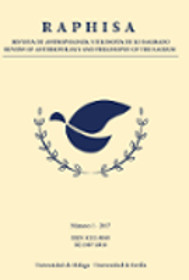Confucianism and Shamanism in the middle Koryŏ period: dynamics of a clash
DOI:
https://doi.org/10.24310/raphisa.7.2.2023.17633Keywords:
Koryŏ, rite, Goryeo, sincretism, chamanism, Confucianism, BuddhismAbstract
This article analyzes the situation of Korean folk native religion, commonly described by the umbrella term "shamanism," during the middle and second part of the Koryŏ period. The study attempts to expand and correct some basic assumptions of the work of Lee Seog-Ju (2010), who described the dialectic existing between the Confucian elite, the royal house, Buddhism and shamanism in the Koryŏ, correcting as mentioned some of the author's historical assumptions. Specifically, consideration will be given to: the pervasiveness of the doctrine in the external help of bodhisattvas in medieval Korea as noted by Yung Sung-chan (2016); the existence of syncretism between Confucian and Buddhist doctrines, noted by Kim Jongmyung (2016) and Vermeersch (2020); the syncretic nature of shamanism in relation to Buddhism, noted by multiple authors such as Grayson (1992) and McBride (2007); and finally, the importance of shamanism in pre-existing national rituals such as the Assembly of Eight Prohibitions, emphasized by Vermeersch (2007). The thesis of this article is demonstrate how the clash with shamanism by Koryŏ Confucian intellectuals was due not so much to a supposed deviation from Confucian orthodoxy by the native religion, but to its non-adherence to the canons of the rituals of State Buddhism. The paper will proceed according to the following pattern: first, the society of the Koryŏ kingdom will be briefly analyzed in its religious, cultural, social and political aspects, then a description of the relationship between the two actors in the field, namely shamanism and Confucianism in relation to Buddhism, will be given, and finally the conclusions of the study will be provided.
Downloads
Metrics
References
Koryŏsa 高麗史 in National Institute of Korean History: https://db.history.go.kr/KOREA/item/level.do?itemId=kr&types=r
Samguk Sagi 三國史記 in National Institute of Korean History: https://db.history.go.kr/item/level.do?itemId=sg
Tongguk Yisangguk-chip 東國李相國集 in Institute for the Translation of Korean Classics: https://db.itkc.or.kr/dir/item?itemId=MO#dir/node?grpId=&itemId=MO&gubun=book&depth=2&cate1=Z&cate2=&dataGubun=%EC%84%9C%EC%A7%80&dataId=ITKC_MO_0004A
Tongmunsŏn 東文選 in Institute for the Translation of Korean Classics: https://db.itkc.or.kr/dir/item?itemId=GO#dir/node?grpId=&itemId=GO&gubun=book&depth=2&cate1=Z&cate2=&dataGubun=%EC%84%9C%EC%A7%80&dataId=ITKC_GO_1365A
Xuanhe fengshi Gaoli tujing 宣和奉使高麗圖經 in Chinese Text Project: https://ctext.org/wiki.pl?if=gb&res=265827
Iscrizioni su pietra o metallo e altre fonti scritte di epoca Koryŏ 고려시대 금석문·문자자료, scritti su stele 碑文, in National Institute of Korean History: https://db.history.go.kr/KOREA/item/gskoList.do?searchType=gsko_001&searchGubun=
Brook Timothy: “Rethinking syncretism: The unity of the three teachings and their joint worship in late-imperial China”. Journal of Chinese religions, 21 No, 1, 1993, 13-44.
Chačatrjan, Arevik: "An Investigation on the history and Structure of Korean Shamanism." International Journal of Korean Humanities and Social Sciences 1, 2015, pp. 55-70.
Cho, Hung-Youn. "Cultural interbreeding between Korean shamanism and imported religions." Diogenes, 47 no. 187, 1999, pp. 50-61.
Choi, Moon-Hyoung: “The Concept of God in the Idea of Hongik ingan.”, The Review of Korean Studies 12 No. 3, 2009: pp. 177-196.
Grayson, James Huntley. “Female Mountain Spirits in Korea: A Neglected Tradition.” Asian Folklore Studies 55, No. 1, 1996, pp. 119-4.
Grayson, James Huntley: "Religious syncretism in the Shilla period: The relationship between Esoteric Buddhism and Korean primeval religion." Asian Folklore Studies, 1984, pp. 185-198.
Grayson, James Huntley: “The accommodation of Korean folk religion to the religious forms of Buddhism: an example of reverse syncretism”. Asian Folklore Studies, 1992, pp. 199-217.
Kim, Jongmyung: "Interactions between Buddhism and Confucianism in Medieval Korea." Korean Religions in Relation: Buddhism, Confucianism, Christianity, 2016, pp. 20-64.
Kim, Staci. "The Ambivalent Perspective on Shamanism in the Joseon Era of Korea." International Journal of Religious and Cultural Studies 4, No. 2, 2022, pp. 137-144.
Kim, Sooyoun: "Esoteric Buddhism and the Cross-cultural Transfiguration of Śūraṃgama-sūtra Faith in Goryeo." Asian Review of World Histories 2, No. 2, 2014, pp. 169-195.
Lee, Jung Young. “Concerning the Origin and Formation of Korean Shamanism.” Numen 20, no. 2, Brill, 1973, pp. 135–59
Lee Peter H. (a cura di), Fonti per lo studio della civiltà coreana, vol. 1, ObarraO, 2000
Mahy, Kaya: "Buddhism during the Goryeo Period." Korean History, 2022.
McBride, Richard, D. II: Yi Kyubo’s “Lay of the Old Shaman.”. Religions of Korea in practice, 2007, pp. 233-243.
Riotto, Maurizio. Storia della Corea dalle origini ai giorni nostri. Bompiani, 2018.
Vermeersch, Sem. "Syncretism, harmonization, and mutual appropriation between Buddhism and Confucianism in pre-Joseon Korea." Religions 11 no. 5, 2020, pp. 231.
Vermeersch, Sem: "The Status of Monks: State Regulations Concerning Buddhist Monks in the Koryo Dynasty." Buddhist Studies Review 20 No. 2, 2003, pp. 145-168.
Vermeersch, Sem: “The P'algwanhoe: From Buddhist Penance to Religious Festival”. Religions of Korea in Practice, 2007, pp. 86-99.
Yang, Eun-Yong: "Buddhist Rituals and It’s Thoughts in the Goryeo Dynasty." 원불교사상과종교문화 49, 2011, pp. 227-244. [Yang, Eun-Yong: "Buddhist Rituals and It’s Thoughts in the Goryeo Dynasty.” Wŏnbulkyo-sasang Kwajonggyo-munhwa 49, 2011, pp. 227-244.]
윤성찬. "단군신화의 제석과 불교의 제석천의 연관성 연구." 고조선단군학 34 (2016): 73-91. [Yung, Sung-chan, “A Comparative Study of Korean and Buddhism ‘Je-seok(Indra)’”, Gojoseon Dan’gun-hak]
이기영. “한국의 불교”, 교양 국사 총서 4 (1974), 세종대왕 기념 사업회 [Yi Gi-yeong, “Hanguk-ŭi Pulgyo”, Kyoyang Kuksa Ch’ongsŏ, Sejongdaewang Kinyŏm Saŏphoe]
이석주, 고려의 제석의례와 유 불 무, 동서철학연구 제58호, 한국동서 찰학회논문집, 2010, 260~284쪽. [Lee, Seog-Ju, Goryeo National Ceremony and Confucianism-Buddhism-Shamanism, Tongsŏ ch’ŏrhak yŏn’gu 58, Han’guktongsŏ Ch’arhakhoenonmunjip, 2010, 260-284]
Downloads
Published
How to Cite
Issue
Section
License
Copyright (c) 2023 Review of Anthropology and Philosophy of the Sacrum

This work is licensed under a Creative Commons Attribution 4.0 International License.
License permitted by the journal: Public Domain. Authors retain the copyright and full publishing rights without restrictions.






